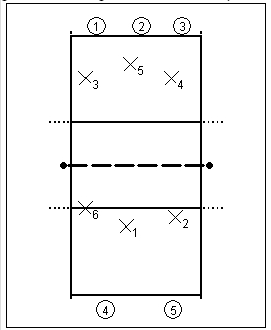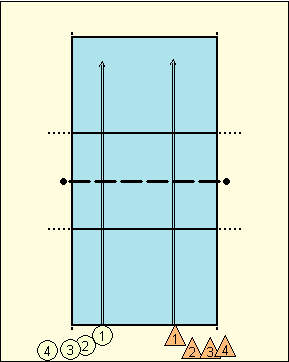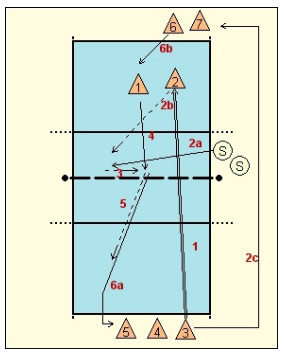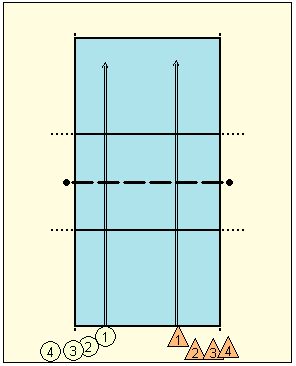Volleyball drills for technique serving
- In every field
- 1 passer,
- 1 catcher,
- 1 reserve and
- 2 servers.
- Serve, reserve, pass, catch and serve.
- Chasing your ball.
- Team 1(balls) get 10 balls to serve with.
- If a ball is passed
- and is caught on the half where it is passed,
- If the ball is hit into the net, it is taken out of play.
- also if it is served out,
- or is served into the net,
- it goes out of play.
- The team that serves the most wins.
Team 1(balls) get 10 balls to serve with. If a ball is passed and is caught on the half where it is passed, then this ball is taken out of play. Also if it is served out, or in the net, then this ball goes out of play. The team that serves the most wins. |
- try to serve 10 times right.
- One error,
- back to 0 points.
- Who finishes first?

This exercise is fun to do and gives a lot of fun and competition! Relays in general already create competition.
What this exercise also wants to mimic is the stress factor that a serve brings.
The players are divided into equal teams and lined up on the serving area of the same court. The first player of a team serves and retrieves his ball. After the next player is tapped, this one serves, and so on.
It is important for a player to serve quickly, but it must also be flawless, otherwise the ball must be retrieved and served again!
If the teams are small, it is fun to let everyone serve two or three times.
Necessary:
- A minimum of 6 players
- As many balls as there are teams
Click here for the meaning of the symbols.
In today's exercise, the following techniques will be used: serving, attacking, passing and distributing. However, the emphasis is on the pass and the distribution. The players have to watch, think well and react adequately during this exercise.
 The diagram looks more complicated than the exercise is. The exercise goes as follows (I keep the numbering of the red numbers):
The diagram looks more complicated than the exercise is. The exercise goes as follows (I keep the numbering of the red numbers):
- 1 player 3 serves
- 2a one of the two playmakers runs to the position at the right front (the playmakers take turns)
- 2b one of the two passers (in this case player 2) passes the ball to the right front side
- 2c player 3 (who has just served) runs to the backline of the other half of the game
- 3 the server gives a setup to the player who did NOT pass. A setup to the centre if player 1 has passed and a setup to the outside if player 2 has passed.
- 4+5 the player who did not pass attacks (in this case player 1)
- 6a the attacker retrieves his own batted ball and joins the back of the line of serves.
- 6b the place where the attacker stood is taken by the first player in the row behind the court.
As soon as the ball is hit the next service is played.
Requirements
- A minimum of 9 players;
- pair of balls;
 This exercise is fun to do and gives a lot of fun and competition! Relays in general already create competition.
This exercise is fun to do and gives a lot of fun and competition! Relays in general already create competition.
What this exercise also wants to mimic is the stress factor that a serve brings.
The players are divided into equal teams and lined up on the serving area of the same court. The first player of a team serves and retrieves his ball. After the next player is tapped, this one serves, and so on.
It is important for a player to serve quickly, but it must also be flawless, otherwise the ball must be retrieved and served again!
If the teams are small, it is fun to have everyone serve two or three times.
- Pairs facing each other with a net in between.
- Server has 2 balls.
- 1 at the foot and
- 1 in the hand.
- Server kicks the ball to the other side,
- Then the server tries to serve on the ball.
- Then it's player two's turn.
- Free serve
- Serve at goal:
- In the three meter,
- in the middle of the field,
- serve against the back,
- against the lines etc.
- 2 teams with 1 ball.
- 1 field full of hoops.
- Player 1 stands in a random hoop and player 2 serves there.
- If player 1 catches the ball without stepping out of the hoop, the hoop is for the pair.
- Who has the most hoops?
- per hoop a pun1
In each field 1 passer, 1 catcher, 1 reserve and 2 server.
Serve, reserve, pass, catch and serve. Chasing your ball.
- 2 teams,
- 1 person in the field
- other on the other side of the net.
- Person stands randomly somewhere in the field,
- server has to look for him in the field.








